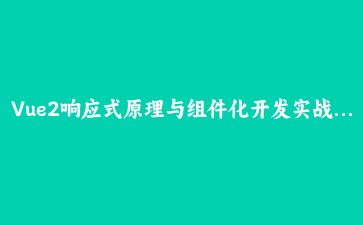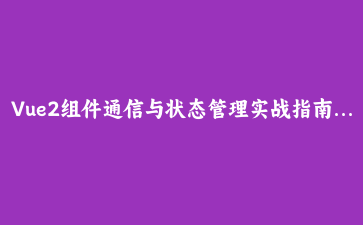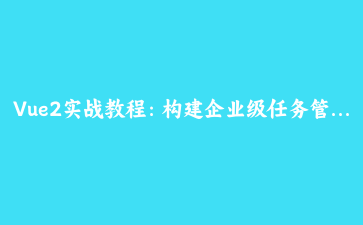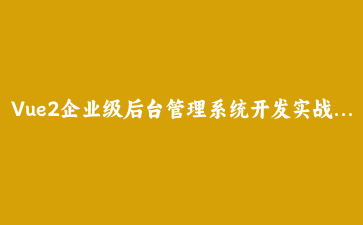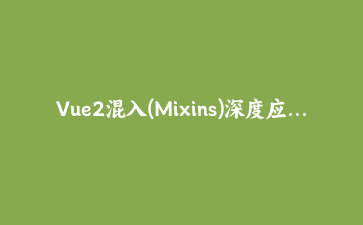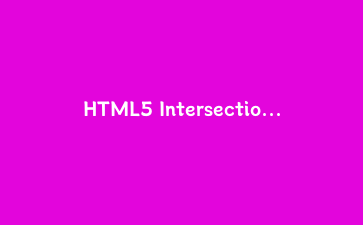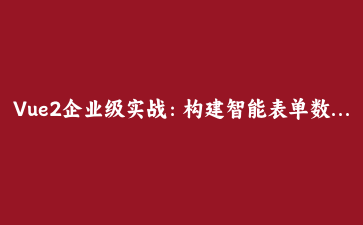深入理解Vue2核心机制,掌握企业级组件开发技巧
Vue2响应式系统原理解析
Vue2使用Object.defineProperty实现数据响应式,这是其核心特性之一。了解这一机制对于深入掌握Vue2至关重要。
数据劫持原理
Vue2通过Object.defineProperty对数据对象的属性进行劫持,实现数据变化时的自动更新。
简单实现示例:
function defineReactive(obj, key, val) {
Object.defineProperty(obj, key, {
enumerable: true,
configurable: true,
get: function() {
console.log('获取值:', val);
return val;
},
set: function(newVal) {
if (newVal === val) return;
console.log('设置值:', newVal);
val = newVal;
// 这里可以触发更新
}
});
}
const data = {};
defineReactive(data, 'message', 'Hello Vue2');
data.message; // 控制台输出: 获取值: Hello Vue2
data.message = 'Hello World'; // 控制台输出: 设置值: Hello World
Vue2正是基于这种机制,在数据变化时能够自动更新相关的DOM元素。
Vue2组件化开发详解
组件化是Vue2的核心概念之一,它允许我们将UI拆分为独立可复用的代码片段。
组件注册与使用
Vue2提供了全局注册和局部注册两种组件注册方式。
// 全局组件注册
Vue.component('my-button', {
template: '',
data: function() {
return {
count: 0
};
}
});
// 局部组件注册
const UserCard = {
template: `
{{ user.name }}
邮箱: {{ user.email }}
`,
props: ['user']
};
new Vue({
el: '#app',
components: {
'user-card': UserCard
}
});
实战案例:用户管理系统
下面我们使用Vue2构建一个简单的用户管理系统,演示组件间通信和状态管理。
用户列表
编辑用户
实现代码解析
// 用户列表组件
Vue.component('user-list', {
props: ['users'],
template: `
-
{{ user.name }} - {{ user.email }}
`
});
// 主Vue实例
new Vue({
el: '#app',
data: {
users: [
{ id: 1, name: '张三', email: 'zhangsan@example.com' },
{ id: 2, name: '李四', email: 'lisi@example.com' }
],
newUser: {
name: '',
email: ''
},
editingUser: null,
editingIndex: -1
},
methods: {
addUser() {
if (this.newUser.name && this.newUser.email) {
this.users.push({
id: Date.now(),
name: this.newUser.name,
email: this.newUser.email
});
this.newUser.name = '';
this.newUser.email = '';
}
},
editUser(user, index) {
this.editingUser = { ...user };
this.editingIndex = index;
},
updateUser() {
if (this.editingUser) {
Vue.set(this.users, this.editingIndex, this.editingUser);
this.cancelEdit();
}
},
deleteUser(index) {
this.users.splice(index, 1);
},
cancelEdit() {
this.editingUser = null;
this.editingIndex = -1;
}
}
});
组件通信模式
Vue2提供了多种组件通信方式,适用于不同的场景:
- Props向下传递:父组件向子组件传递数据
- Events向上传递:子组件向父组件发送消息
- Event Bus:非父子组件间通信
- Vuex:大型应用的状态管理
Event Bus示例
// 创建Event Bus
const eventBus = new Vue();
// 组件A发送事件
Vue.component('component-a', {
template: '',
methods: {
sendMessage() {
eventBus.$emit('message-sent', 'Hello from Component A');
}
}
});
// 组件B接收事件
Vue.component('component-b', {
template: '收到消息: {{ message }}',
data() {
return {
message: ''
};
},
created() {
eventBus.$on('message-sent', (message) => {
this.message = message;
});
}
});
Vue2生命周期深度解析
理解Vue2生命周期钩子对于掌握组件行为至关重要。
主要生命周期钩子:
- beforeCreate:实例初始化之后,数据观测之前
- created:实例创建完成,数据观测已完成
- beforeMount:挂载开始之前,模板编译完成
- mounted:实例挂载到DOM上
- beforeUpdate:数据更新时,虚拟DOM重新渲染之前
- updated:数据更改导致的虚拟DOM重新渲染完成
- beforeDestroy:实例销毁之前
- destroyed:实例销毁后
Vue.component('example-component', {
template: '{{ message }}',
data() {
return {
message: 'Hello Vue2'
};
},
beforeCreate() {
console.log('beforeCreate: 实例刚创建');
},
created() {
console.log('created: 实例创建完成');
},
beforeMount() {
console.log('beforeMount: 挂载前');
},
mounted() {
console.log('mounted: 已挂载');
},
beforeUpdate() {
console.log('beforeUpdate: 更新前');
},
updated() {
console.log('updated: 更新后');
},
beforeDestroy() {
console.log('beforeDestroy: 销毁前');
},
destroyed() {
console.log('destroyed: 已销毁');
}
});
总结
Vue2作为一个成熟的前端框架,其响应式系统和组件化开发模式为构建复杂应用提供了强大支持。通过本文的讲解和实战案例,你应该对Vue2的核心概念有了更深入的理解。
虽然Vue3已经发布,但Vue2仍然在许多项目中广泛使用,掌握其核心原理和开发模式对于前端开发者来说仍然非常重要。
建议在实际项目中多加练习,深入理解Vue2的各种特性和最佳实践。
// 用户列表组件
Vue.component(‘user-list’, {
props: [‘users’],
template: `
-
{{ user.name }} – {{ user.email }}
`
});
// 主Vue实例
new Vue({
el: ‘#app’,
data: {
users: [
{ id: 1, name: ‘张三’, email: ‘zhangsan@example.com’ },
{ id: 2, name: ‘李四’, email: ‘lisi@example.com’ }
],
newUser: {
name: ”,
email: ”
},
editingUser: null,
editingIndex: -1
},
methods: {
addUser() {
if (this.newUser.name && this.newUser.email) {
this.users.push({
id: Date.now(),
name: this.newUser.name,
email: this.newUser.email
});
this.newUser.name = ”;
this.newUser.email = ”;
}
},
editUser(user, index) {
// 创建副本以避免直接修改props
this.editingUser = { …user };
this.editingIndex = index;
},
updateUser() {
if (this.editingUser) {
// 使用Vue.set确保响应式更新
this.$set(this.users, this.editingIndex, this.editingUser);
this.cancelEdit();
}
},
deleteUser(index) {
this.users.splice(index, 1);
},
cancelEdit() {
this.editingUser = null;
this.editingIndex = -1;
}
}
});


